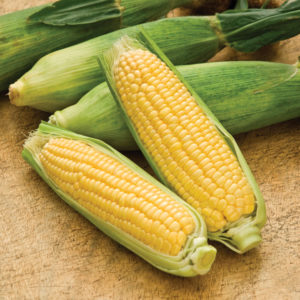 Corn gained on Wednesday, extending Tuesdays biggest gain in 10 weeks as analysts expected the U.S. Department of Agriculture to trim its U.S. crop outlook. Wheat and soybeans marked minor daily gains.
Corn gained on Wednesday, extending Tuesdays biggest gain in 10 weeks as analysts expected the U.S. Department of Agriculture to trim its U.S. crop outlook. Wheat and soybeans marked minor daily gains.
On the Chicago Board of Trade, corn futures for September delivery traded at $5.5425 a bushel at 10:00 GMT, up 0.48% on the day. Prices swung between gains, hitting a daily high of $5.5463 and low at $5.4850. The grain posted its biggest gain in 10 weeks yesterday, settling the day around 3.4% higher and bringing this weeks advance to 5%. Corn settled 3.72% lower last week after it lost the staggering 17.26% the preceding one.
According to a Bloomberg survey among 20 analysts and trading firms, corn output in the U.S. should total 13.983 billion bushels this year, below the previous prediction of 14.005. The U.S. Department of Agriculture will update its production outlook on July 11.
Luke Mathews, a commodity strategist at Commonwealth Bank of Australia, wrote in a report: “The main drivers of the renewed price strength is short covering ahead of this Thursday’s July USDA WASDE report and concern that hot, dry weather during pollination could hurt U.S. corn-yield prospects,” he referred to the World Agricultural Supply and Demand Estimates.
In its weekly crop progress report on Monday, the USDA said that corn silking fell behind last year’s pace. As of the week ending July 7, 6% of the corn crop was silked, slightly above the preceding week’s 3%, but well below last year’s 46% and the five-year average 20%.
As for the corn crop conditions, the USDA reported it is a lot better than 2012. As of July 7, only 8% of the crop was categorized as “Very poor” and “Poor”, 24% was “Fair” and 68% was of “Good” and “Excellent” qualities. In comparison, during the same week last year, 36% of the crop fell in the “Very poor” and “Poor” categories, 30% in “Fair” and 40% was categorized as “Good” and “Excellent”.
The U.S. Department of Agriculture reported last Friday of June that 97.4 million acres of land was sown to corn, the highest since 1936. U.S. Increased production is expected in the U.S., European Union and Ukraine and other former Soviet Union countries.
Wheat posts minor advance
Wheat swung between gains and losses and remained fairly unchanged at $6.7788 a bushel at 9:53 GMT, up 0.07% on the day. The September contract held in range between $6.7950 and $6.7163 a bushel. The grain gained 2.1% on Tuesday and has advanced 2.7% so far this week after settling 0.46% higher the previous one.
Prices were supported as different importers sought to fill stockpiles, lured by low prices as futures in Chicago fell 29% amid ample global supply from the U.S., EU members, Ukraine and other former Soviet Union members.
Wheat imports from Pakistan, Asias third biggest producer, may surge to the highest level in 5 years following a decline in the countrys crop harvest that boosted local prices, making imports more competitive. Abdul Kalim Baakza, senior vice chairman of the Karachi-based Wheat Traders’ Association of Pakistan said for Bloomberg: “We may import up to 500,000 tons of wheat this year.” Traders have already purchased a total 200 000 tons of wheat from the Black Sea Region this year.
Meanwhile, Japan is seeking to buy U.S. wheat as an alternative to the genetically modified Oregon wheat, whose import in the Asian country was suspended. The suspension was extended for a sixth week. Japan plans to buy 23 963 metric tons of club wheat grown in Washington state, 1 710 tons of soft-red winter, 1 497 tons of Australian premium-white and 22 784 tons of western-red-spring wheat from Canada.
The International Grains Council said last week that global wheat production may rise 4.2% compared to a year earlier and total 683.1 million tons, 1 million more than the previous estimate. The USDA expects global output to surge by 6.1% to 696 million tons.
The USDA said in its weekly crop progress report on Monday that 57% of the U.S. winter wheat crop was harvested as of July 7, compared to 43% a week earlier. This however was below last year’s 78% and the five-year average 64%.
As for the spring wheat crop, 98% had emerged as of last week, compared to 93% during the preceding one, but below last year’s full emergence and the five-year average 99%.
As for the spring wheat condition, the USDA reported that this year’s crop is of relatively the same quality like last year’s. As of July 7, 5% of the crop was categorized as “Very poor” and “Poor”, 27% was “Fair” and 72% was of “Good” and “Excellent” quality. Meanwhile, 7% of last year’s crop fell in the “Very poor” and “Poor” categories, 27% in “Fair” and the remaining 56% in “Good” and “Excellent”.
Soybeans slightly up
Soybeans also fluctuated, erasing earlier daily losses. Soybeans for August delivery traded at $14.6913 at 10:02 GMT, up 0.05% on the day. Prices held in range between days high and low of $14.7150 and $14.6238 a bushel respectively. The oilseed gained 0.8% yesterday, bringing this weeks advance to 2.5%. The grain closed 0.19% higher last week after falling 4.17% the preceding one.
U.S. farmers are expected to reap a record amount of soybeans this year. The USDA said in its acreage report in the end of June that the U.S. soybean planted area is estimated at a record high of 77.7 million acres, up 1% compared to last year. Area for harvest, at 76.9 million acres, is up 1% from 2012 and will also be a record high, if realized.
The oilseed drew support yesterday by a sailor strike at Argentina’s Timbues/San Lorenzo port that disrupted grain shipments. Tetsu Emori, a commodity fund manager at Astmax Asset Management Inc., commented for Bloomberg: “China is probably struggling to import soybeans and soybean meal from the U.S. after the Argentine strike.” China is the world’s biggest consumer while the U.S. is the top grower and exporter.
In its weekly crop progress report, the USDA said that as of July 7 95% of the nation’s soybean crop had emerged, up form the preceding week’s 91%, but below last year’s full emergence and the 97% five-year average.
As for the soybeans condition, the government agency reported it was a lot better than last year’s. This year, 7% of the crop was categorized as “Very poor” and “Poor”, 26% was “Fair” and 67% was “Good” and “Excellent”. As of July 7, 2012, 27% of the crop was of “Very poor” and “Poor” quality, 33% was “Fair” and the remaining 40% was of “Good” and “Excellent” quality.





